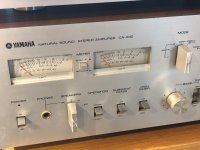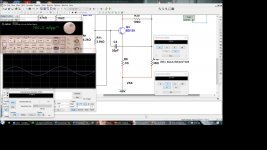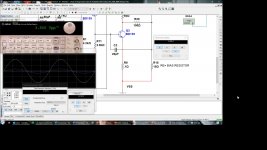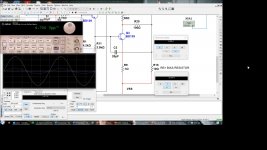Two mono amplifiers with 1 serial number? Then it still is likely added up. It would be unlikely to call a channel outputting 236W/8Ohm and more than 422W/4Ohm a 100W channel.
This thread is like ordering food in china in dutch 🙂
This thread is like ordering food in china in dutch 🙂
Last edited:
Is it also possible to put a pot on the front of the amp so you can regulate within safe borders the amount of applied quiescent current yourself, as a matter of personal taste?Yes I know.
I'm taking another Approach, then what Krell and Mr. Pass did
I will cut the power down, to almost nothing, but the AMP still has some sound in CLASS A Mode and about 2 watts, as signal increases Full BIAS will be applied. and then also the period of time can be adjusted by the owner or user or whoever uses the amp.. it also can be switched that this SMART PART is off.
Two mono amplifiers with 1 serial number? Then it still is likely added up. It would be unlikely to call a channel outputting 236W a 100W channel.
This thread is like ordering food in china in dutch 🙂
No it's one rapport for one mono-amplifier.
It's also 1 KHz at 1% THD.
I remember that the Levinson ML-3 I had was specified for 200 Watts a channel also delivered over 300 Watts in reality.
I think those specifications were kept low to get a low distortion spec like with cars to get a optimal mileage per gallon.
Well that makes it an even better device.
Regarding your remark of setting bias on the front, this already was done in Hawk Audio devices and Marantz PM80 a long time ago by means of a switch. In some cases the device was meant to be powered on continuously making the ClassAB/A switch kind of power (save) switch. It involves a big risk though.
Regarding your remark of setting bias on the front, this already was done in Hawk Audio devices and Marantz PM80 a long time ago by means of a switch. In some cases the device was meant to be powered on continuously making the ClassAB/A switch kind of power (save) switch. It involves a big risk though.
Last edited:
Is it also possible to put a pot on the front of the amp so you can regulate within safe borders the amount of applied quiescent current yourself, as a matter of personal taste?
NO.! It has to be AUTOMATICALLY..
I want to listen to music not standing up and walking around and screwing on the amp-..
I use REMOTE a lot at home, but not in the SOUND PATH, neither PREAMP Nor AMP.
It's in fact Easy but it's complete out of MIND, I will cut the power at the Transformers, when using under 2 watt there will be another set of Transformers, just small ones enough to feed 5 watts, @ 10 Volts Rail, but using only Power for 2 watts,. and the rest is so easy as eating peanuts.
But I'm an old man, and have many other things, so I take my time, because this will be created just for fun.
If you ever have looked at one of my circuits " Have to say, MR. Nelson Pass" helped me a lot with suggestions.. then you will see in the last circuit I always use a PID.
When running the amp on less than +-Vrail 15 Volts, PID is not needed.
The small transformers will feed the regular PSU, over a second set of Diodes but with the same Filter caps.. so instead of having the 25 AMPS transformes feeding the brigde rectifiers, just these small ones will feed. then using a SCMHITT Trigger to on of the big Transformers according to time and Output level. it is more than that.. but that is the main thing.. how to do.
Or I can just change RE to higher level this automatically decreases BIAS.
right now I'm testing all options.
I could set a NE555 Timer with a relay and some 4017 or a Nand gate, but I want to stay Analogue.
Anyway thanks for the input.
Regards
Chris
Last edited:
The use of efficient speakers with low power amplifiers would be the logical step to do. Perhaps Europeans in general do not find energy price to be that expensive considering widespread use of inefficient speakers and high power amplifiers.... Since we are in Europe there is some consensus not to waste energy and secondly energy is expensive here as well...
Energy is the one thing that one can not miss even in a crisis like the one we are now in. One can resign from magazines and newspapers, sell the car and go by bicycle, don't order take away food and cook oneself, stop going out... but a warm house, hot water and light are essential. With only rising prices energy will be key in the near future. Audio is a dying market and what is sold to the general public are already higher efficiency speakers and class D stuff (even in cars). The part of audio in total energy consumption in normal households is very low as many don't even have audio anymore (yes, horror!) and other household devices use way more energy. Many are conscious about energy use and try to waste less water and energy so I think your statement is odd.
You mention high power amplifiers but those are either class D or AB with low idle power consumption in general. Ready built Class A straight from the store is a true niche market for people with bigger pockets that often don't hesitate to show off their wealth (which is OK) but it is only a very small part of the total. A gentleman in this thread told us he spent 2600 Euro per 6 months to have his class A amplifier powered on continuously but I somehow suspect not many normal citizens will do so as they have trouble enough to survive the month.
You mention high power amplifiers but those are either class D or AB with low idle power consumption in general. Ready built Class A straight from the store is a true niche market for people with bigger pockets that often don't hesitate to show off their wealth (which is OK) but it is only a very small part of the total. A gentleman in this thread told us he spent 2600 Euro per 6 months to have his class A amplifier powered on continuously but I somehow suspect not many normal citizens will do so as they have trouble enough to survive the month.
Last edited:
Missed that one! More then 400 EUR a month to keep his amp(s) on continuously?Ready built Class A is a true niche market for people with bigger pockets that often don't hesitate to show off their wealth (which is OK). A gentleman in this thread told us he spent 2600 Euro per 6 months to have his class A amplifier powered on continuously but I somehow suspect not many normal citizens will do so.
I do not have big pockets or wealth. I bought a 30 year old amplifier actually to sell it on but found out it sounded so well I decided to keep it.
Can't afford a Tesla P100D but a secondhand V8 muscle car was within my financial reach...
Besides "absolute' and "relative" there also exists "in general" 🙂 I was not addressing to you personally but I nevertheless edited my post accordingly.
Last edited:
Regarding your remark of setting bias on the front, this already was done in Hawk Audio devices and Marantz PM80 a long time ago by means of a switch. In some cases the device was meant to be powered on continuously making the ClassAB/A switch kind of power (save) switch. It involves a big risk though.
Yes I know that provision from an amplifier of the late seventies the Yamaha CA-1010:
https://www.diyaudio.com/forums/attachment.php?attachmentid=936346&stc=1&d=1616863278
Under 'Operation" you switch to Class A and the output would be two times 20 Watts if I remember correctly.
Attachments
An elegant way of having best of both worlds. The risk is your audio buddies call it an AB amplifier. Instant breakdown.
@Jean-Paul
You see, I use my systems almost 8 - 10 hours after I come home from work, where I have worked 8 hours at the least and this at almost 69..
Now my Amps draw per side when running about 300Watts, for an output of 30Watts. This is not the amp you see here, but similar to this. this one has a max output 50Watts@4ohms
And the first thing what I do when I'm coming home is, switching on RADIO STATION Antenne Bayern or in English Antenna Bavarian.. Good music most times,
So, I come home 3 - 4 pm then the Class A runs to midnight.. or longer till 2 am.
My Speakers are I.O.Series TED 4, SPL is more than 90DB and good sound, have other ones as well.
But there are besides that a lot of other equipment running when I'm in my test/Working room, at least 6 computers are also running in my house. Every room 1 Computer.
I upload pictures where you can see 3 Ways to cut down power with The Bias Resistor..
Check ampere meter volt meter distortion meter and Sine wave, and this is on Vrail +- 55Volts. corresponding Power you can evaluate from the Number you can see, This is Simulation,., but usually it then works as I simulate it.
Shown are pics for 1 Watt @ 4.3 Ohms, 50Watt @4.3 Ohms and 80 Watts @4.3 Ohms
But Input power differs by as much as 3 ampere between the 1 watt and 80 watt Look at the RE
This is one way to cut down power consumption while the amp is not performing music but not switched off.
I think cutting down power that way will reduces costs in Electricity by at least the half.
Happy Weekend There are some thoughts of NELSON PASS in this circuit To get more POWER VS DISSIPATION.
Chris
You see, I use my systems almost 8 - 10 hours after I come home from work, where I have worked 8 hours at the least and this at almost 69..
Now my Amps draw per side when running about 300Watts, for an output of 30Watts. This is not the amp you see here, but similar to this. this one has a max output 50Watts@4ohms
And the first thing what I do when I'm coming home is, switching on RADIO STATION Antenne Bayern or in English Antenna Bavarian.. Good music most times,
So, I come home 3 - 4 pm then the Class A runs to midnight.. or longer till 2 am.
My Speakers are I.O.Series TED 4, SPL is more than 90DB and good sound, have other ones as well.
But there are besides that a lot of other equipment running when I'm in my test/Working room, at least 6 computers are also running in my house. Every room 1 Computer.
I upload pictures where you can see 3 Ways to cut down power with The Bias Resistor..
Check ampere meter volt meter distortion meter and Sine wave, and this is on Vrail +- 55Volts. corresponding Power you can evaluate from the Number you can see, This is Simulation,., but usually it then works as I simulate it.
Shown are pics for 1 Watt @ 4.3 Ohms, 50Watt @4.3 Ohms and 80 Watts @4.3 Ohms
But Input power differs by as much as 3 ampere between the 1 watt and 80 watt Look at the RE
This is one way to cut down power consumption while the amp is not performing music but not switched off.
I think cutting down power that way will reduces costs in Electricity by at least the half.
Happy Weekend There are some thoughts of NELSON PASS in this circuit To get more POWER VS DISSIPATION.
Chris
Attachments
Haha, your audio buddies...An elegant way of having best of both worlds. The risk is your audio buddies call it an AB amplifier. Instant breakdown.
Well I was very happy with Class AB amplifiers for years but now I found Class A and a world did open up...
No, kidding. I know in essence you can say that all Push Pull amps are Class AB amps but differ how much quiescent current they use.
The articles on the PL website I quoted clearly favor to use a lot of it for several reasons but mainly to reduce distortion without having to resort to complex circuits and NFB to get (static) good results. It's better to make the system behave linear from the beginning then having to correct it afterwards and introduce other forms of distortion.
Last edited:
OK no sweat didn't know that you own the place..
And I hope that you find your answer.
Enjoy weekend
Chris
And I hope that you find your answer.
Enjoy weekend
Chris
Last edited:
OK no sweat didn't know that you own the place..
And I hope that you find your answer.
Chris
Do not understand you.
I do not own any place besides my home and what's in it except my wife of course 😛
@hpro: the other way of thinking is to start from 0. Or take 0 as the goal. Maybe not the best for audio but a challenge on its own 🙂
It's only audio... ones life does not depend on it thankfully.
It's only audio... ones life does not depend on it thankfully.
Last edited:
I always start from 0, going one step at the time, but keeping yourself to long on 0 then you miss the goal.. (With this I don't mean you or anyone one else) it's just that it happen that way.
But anyway thanks for the advice. I appreciate this.
Enjoy weekend..
Cheers
But anyway thanks for the advice. I appreciate this.
Enjoy weekend..
Cheers
Excuse the generalisations. I know not all amps are made equal.
I partly agree with ZenMod . - low watt, high quality amps with efficient speakers - great! Unfortunately it's an expensive road to take with a lack of options for affordable (DIY or commercial) pairs of efficient (min spl 92 dB) speakers with good bass extension that aren't huge.
Apart from my Bottlehead headphone amp, I've only ever heard class A/B amps - until a few months ago when I bought a 3e Audio 3250 class D (50w pc) and more recently a Reisong A10 EL34 @ 6w pc. At first I disliked the class D- bright, forward, very cold and clinical with a harshness in the upper mids. Only positive was the crisp clean bass. The A10 amp, too bright and lacking the bass of D and A/B, though the mids have improved over time and are 'warming up' (only a month old).
After comparing all 3 amps, the EL34 is great for vocals, classical, jazz, acoustic instruments and live recordings - in fact it makes all music sound 'live'. Doesn't do well with electronic, rap or rock, anything with bass or bad recordings.
The class D is great for rap and electronic - anything that requires bass. And with a bit of eq'ing, is on par with my A/B. It's openness and clarity need a good source though. N.B A lot of the high-end D amps have a tube preamp to give warmth. Maybe a future DIY project.
The A/B is the kindest amp - not as bright for starters. It's a Rotel from the 1991. I don't know if modern A/Bs of the same price range have a different sonic signature, but mine is laid back, decent bass, slightly rolled off highs. It's a good all-rounder, easy on the ears and doesn't need high quality source.
SS class A -no idea. Would love to hear a good Pass/Krell etc.
I partly agree with ZenMod . - low watt, high quality amps with efficient speakers - great! Unfortunately it's an expensive road to take with a lack of options for affordable (DIY or commercial) pairs of efficient (min spl 92 dB) speakers with good bass extension that aren't huge.
Apart from my Bottlehead headphone amp, I've only ever heard class A/B amps - until a few months ago when I bought a 3e Audio 3250 class D (50w pc) and more recently a Reisong A10 EL34 @ 6w pc. At first I disliked the class D- bright, forward, very cold and clinical with a harshness in the upper mids. Only positive was the crisp clean bass. The A10 amp, too bright and lacking the bass of D and A/B, though the mids have improved over time and are 'warming up' (only a month old).
After comparing all 3 amps, the EL34 is great for vocals, classical, jazz, acoustic instruments and live recordings - in fact it makes all music sound 'live'. Doesn't do well with electronic, rap or rock, anything with bass or bad recordings.
The class D is great for rap and electronic - anything that requires bass. And with a bit of eq'ing, is on par with my A/B. It's openness and clarity need a good source though. N.B A lot of the high-end D amps have a tube preamp to give warmth. Maybe a future DIY project.
The A/B is the kindest amp - not as bright for starters. It's a Rotel from the 1991. I don't know if modern A/Bs of the same price range have a different sonic signature, but mine is laid back, decent bass, slightly rolled off highs. It's a good all-rounder, easy on the ears and doesn't need high quality source.
SS class A -no idea. Would love to hear a good Pass/Krell etc.
- Home
- Amplifiers
- Pass Labs
- Class A in itself benificial?



